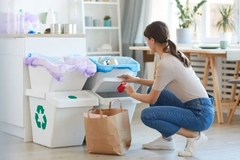Composting Consortium reveals findings from largest ever North American field test

19 Apr 2024 --- The Composting Consortium has released a new study analyzing the disintegration of over 23,000 units of compostable packaging in what it says is the largest known field test of certified, food-contact compostable packaging conducted in North America.
The study shows higher disintegration rates for compostable plastics than for compostable fibers and suggests differing methods for improvement, such as brands using surface area measurements when testing their compostable products and packaging at compost facilities.
Roughly one-third of the world’s food is wasted each year and sent to landfills –– a loss of roughly US$230 billion. State and local authorities are implementing policies throughout the US requiring organics collection to divert food scraps from landfills.
The US composting industry has also increased its capacity to process food waste. According to the consortium, as compostable packaging gains traction, roughly 70% of food waste composters now accept some form of this packaging.
However, limited public information is available on how well-certified, food-contact compostable packaging successfully breaks down in real-world composting facilities –– or on the conditions that best support disintegration. In the UK, a 2022 study found that most home composting claims were false.
The consortium’s new report intends to fill “a critical data gap,” supporting the industry’s transition and helping ensure the responsible growth of compostable packaging and composting infrastructure.
“The Composting Consortium seeks to replace anecdotes with data and opinions with insights, which can drive discussions, decisions and policymaking that will shape a more sustainable and circular future for composting and compostable packaging industries,” says the organization.
 Composting can offer a way out of plastic pollution and food spoilage.Key takeaways
Composting can offer a way out of plastic pollution and food spoilage.Key takeaways
This study found that overall, compostable packaging breaks down successfully at composting facilities that meet reasonable operational parameters (for example, compost pile temperatures, moisture, oxygen and pH value).
Compostable plastic packaging and products broke down successfully across five composting methods and all ten facilities’ varying processing timeframes and operating conditions, achieving 98% disintegration on average by surface area, which exceeds industry thresholds to achieve a 90% or higher disintegration.
Compostable fiber packaging and products achieved 83% disintegration on average by surface area, meeting industry thresholds to achieve an 80% or higher disintegration. Findings showed that certain operating conditions, like turning, agitation and consistent moisture levels above 50%, support increased disintegration of fiber packaging and products.
Diane Hazard, executive director of the Compost Research and Education Foundation, says:“The collaborative approach and open-source data from this project both advances field testing methods and equips compost manufacturers and brands with the knowledge to better understand the variability of disintegration across different systems, all major steps toward successfully processing compostable packaging.”
Frank Franciosi, executive director of the US Composting Council, an industry partner of the Composting Consortium, adds: “Brands and manufacturers must prioritize material selection and design and labeling for compostable packaging to achieve optimal performance in composting environments, which can then incentivize composters to accept food-contact compostable packaging materials at their facilities.”
“As feedstock for composters becomes diversified and more complex, it’s important for all entities within the supply chain to support consumer education on source separation of organics and reevaluate best management practices to support those composters who choose to accept compostable packaging, and this study is another tool for our industry to be able to start that process.”
By Louis Gore-Langton











